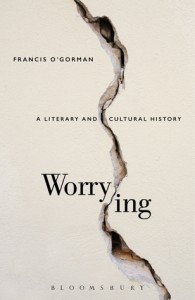 “What if … ?” This is the key question that confronts all worriers, their dominant question about an ever-uncertain future. Professor O’Gorman, who teaches at the University of Leeds (U.K.) readily admits he is a worrier, and, in this slim volume (163 pages) he deftly probes, with humility plus good humor, the various definitions, strategies, relevant observations, advantages, and consolations, concluding with some fatalism that there may be little he can do about his condition. He actually begins with his end, “If we can’t ‘cure’ worry, we can venture to understand it – for better or worse.”
“What if … ?” This is the key question that confronts all worriers, their dominant question about an ever-uncertain future. Professor O’Gorman, who teaches at the University of Leeds (U.K.) readily admits he is a worrier, and, in this slim volume (163 pages) he deftly probes, with humility plus good humor, the various definitions, strategies, relevant observations, advantages, and consolations, concluding with some fatalism that there may be little he can do about his condition. He actually begins with his end, “If we can’t ‘cure’ worry, we can venture to understand it – for better or worse.”
Here is his definition: “Worry is a form of fretfulness, of mental uncertainty and persistently tremulous bother,” the “fretful evaluations of the options in our life.” English has many synonyms: fretting, anxiety, bother, concern, fidgeting, doubt, nervousness, apprehension, and perplexity. Rodgers and Hart expressed them well in their hit song from Pal Joey (1940), “Bewitched, Bothered, and Bewildered.”
The dictionary’s verb is defined as “to feel uneasy or concerned about something,” but it also has an alternative “to pull or tear at something, as with the teeth.” It is when normal worry disintegrates into the dog’s work that we become concerned.
So is worry abnormal? For many of us it is a compulsive habit, “part of the fabric of life,” as O’Gorman argues, but too often seen as anti-social. He suggests: “Life is overflowing with opportunities to fret!”
For some of us who are trying to manage organizations facing numerous “risks,” “worry’s primary concern is about an uncertain future or, more exactly, about a future that has some element of the uncertain in it.” Our problem is that one “worry leads to another, and consequential worries.” And that is unhealthy as too many of us have a “fixed belief that there is, today, something risky about tomorrow.” We end up fearing, not relishing, the future.
Indeed, “daring to be happy is a risk” in itself to a worrier.
Dr. O’Gorman suggests that “worry” also breeds ritual: routines, religions, compulsive habits, not all pleasant. “The fundamental tenets of the major world religions will look delusional to the skeptic atheist, while seeming the brightest of reality to the believer.” So who is right? What is sanity? The author suggests a re-statement of Descartes’ mantra: “I worry; therefore I am.”
His arguments are ripe with the pertinent and often amusing citations of an enormous range of writers: Bronte, T.S. Eliot, George Eliot, the Bible, Shakespeare, Trollope, Kipling, Auden, Woolf, Joyce, Hardy, Darwin, Gladstone, Descartes, Homer, Mill, Sebald, Boswell, Frost, and, above all, Bach. Plus, of course, numerous academics.
Is reason an antidote for worry? “Reason can gather information. It can enumerate the issues. It can search out matters pertinent to the problem in hand. But the worrier’s reason is notoriously bad at suggesting a way forward.” “Worry’s a kind of mental risk assessment that regularly fails to result in an action plan …”
O’Gorman elaborates, “Our reasoning mind has come, in the contemporary world, to be bogged down in debilitating conditions of fretful decision-making and persistent blame, the grim and politicizing consequences of the apparently innocent and cheering pleasures of choosing.” And, “We run through options, assimilating and listening for the give-away signs of ideas we haven’t listened to. We’re always alert to the snuffling in the undergrowth of bristly problems we’ve not already imagined. We’re analysts who are genuinely good at analyzing even if we take little pleasure in our gifts and frequently fail to adjudicate on the most likely outcomes.”
What is the alternative? Should we all become Doctor Panglosses who exist in this, the most perfect, world? O’Gorman does offer the idea that the “arts” (painting, poetry, and especially music) can divert the worrier, but not permanently. They are, to him, a temporary distraction.
His book was a temporary but thoroughly engaging distraction for me, a non-worrier. I think like Alfred E. Neuman, the cover cartoon character for MAD Magazine, who persistently stated, “What? Me worry?”
I’m also reminded of the classic folk song of the Carter Family, first sung in 1930, “It takes a worried man to sing a worried song.” The last line is the best: “I’m worried now but I won’t be worried long!”
Editor’s Note: Francis O’Gorman, Worrying: A Literary and Cultural History, Bloomsbury, London 2015.
 About the Author: Felix Kloman is a sailor, rower, husband, father, grandfather, retired management consultant and, above all, a curious reader and writer. He’s explored how we as human beings and organizations respond to ever-present uncertainty in two books, ‘Mumpsimus Revisited’ (2005) and ‘The Fantods of Risk’ (2008). A 20-year resident of Lyme, he now writes book reviews, mostly of non-fiction that explores our minds, our behavior, our politics and our history. But he does throw in a novel here and there. For more than 50 years, he’s put together the 17 syllables that comprise haiku, the traditional Japanese poetry, and now serves as the self-appointed “poet laureate” of Ashlawn Farms Coffee, where he may be seen on Friday mornings. His wife, Ann, is also a writer, but of mystery novels, all of which begin in a bubbling village in midcoast Maine, strangely reminiscent of the town she and her husband visit every summer.
About the Author: Felix Kloman is a sailor, rower, husband, father, grandfather, retired management consultant and, above all, a curious reader and writer. He’s explored how we as human beings and organizations respond to ever-present uncertainty in two books, ‘Mumpsimus Revisited’ (2005) and ‘The Fantods of Risk’ (2008). A 20-year resident of Lyme, he now writes book reviews, mostly of non-fiction that explores our minds, our behavior, our politics and our history. But he does throw in a novel here and there. For more than 50 years, he’s put together the 17 syllables that comprise haiku, the traditional Japanese poetry, and now serves as the self-appointed “poet laureate” of Ashlawn Farms Coffee, where he may be seen on Friday mornings. His wife, Ann, is also a writer, but of mystery novels, all of which begin in a bubbling village in midcoast Maine, strangely reminiscent of the town she and her husband visit every summer.